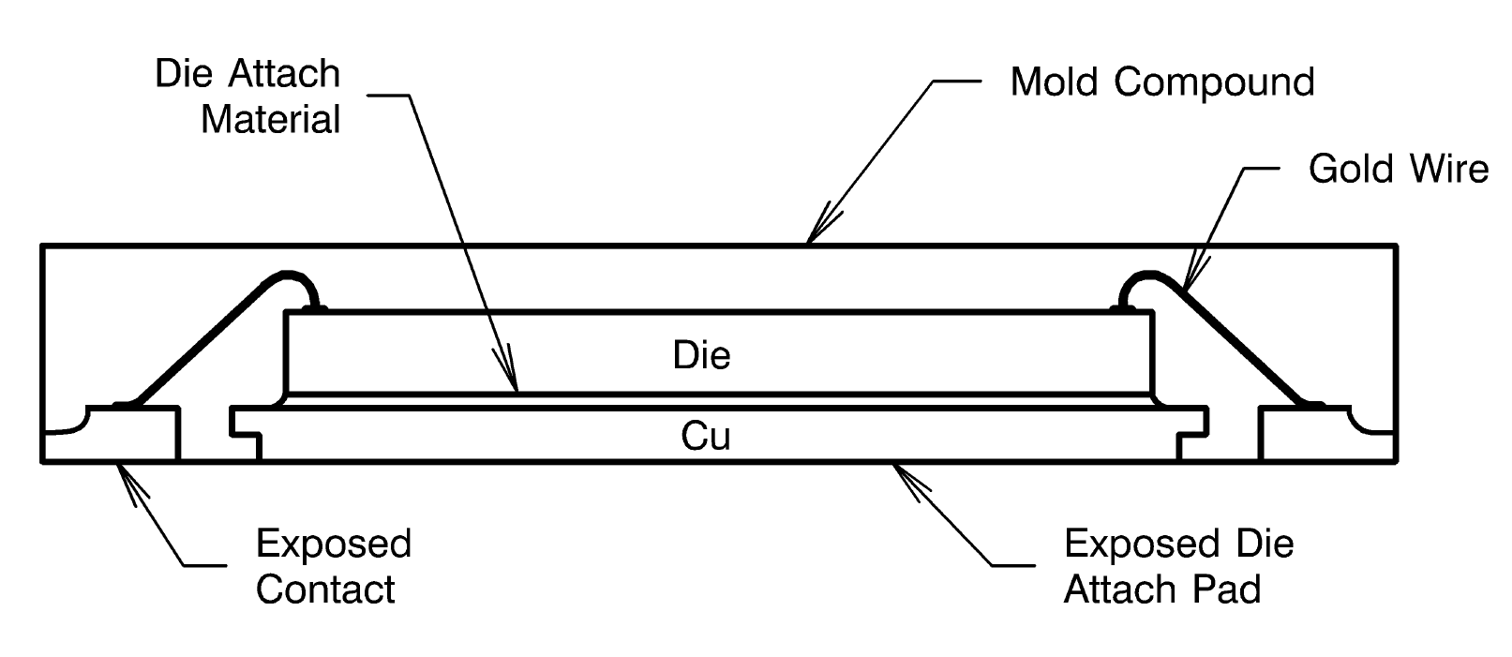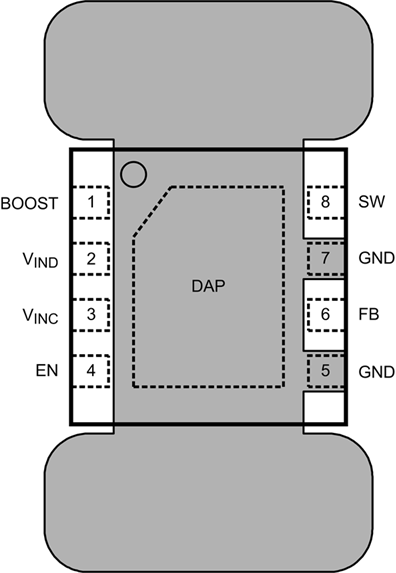SNVS556C April 2008 – January 2016 LM2738
PRODUCTION DATA.
- 1 Features
- 2 Applications
- 3 Description
- 4 Revision History
- 5 Pin Configuration and Functions
- 6 Specifications
- 7 Detailed Description
-
8 Application and Implementation
- 8.1 Application Information
- 8.2
Typical Applications
- 8.2.1 LM2738X Circuit Example 1
- 8.2.2 LM2738X Circuit Example 2
- 8.2.3 LM2738X Circuit Example 3
- 8.2.4 LM2738X Circuit Example 4
- 8.2.5 LM2738X Circuit Example 5
- 8.2.6 LM2738Y Circuit Example 6
- 8.2.7 LM2738Y Circuit Example 7
- 8.2.8 LM2738Y Circuit Example 8
- 8.2.9 LM2738Y Circuit Example 9
- 8.2.10 LM2738Y Circuit Example 10
- 9 Power Supply Recommendations
- 10Layout
- 11Device and Documentation Support
- 12Mechanical, Packaging, and Orderable Information
Package Options
Mechanical Data (Package|Pins)
Thermal pad, mechanical data (Package|Pins)
- DGN|8
Orderable Information
10 Layout
10.1 Layout Guidelines
When planning layout there are a few things to consider when trying to achieve a clean, regulated output. The most important consideration is the close coupling of the GND connections of the input capacitor and the catch diode D1. These ground ends must be close to one another and be connected to the GND plane with at least two through-holes. Place these components as close as possible to the device. Next in importance is the location of the GND connection of the output capacitor, which must be near the GND connections of CIN and D1. There must be a continuous ground plane on the bottom layer of a two-layer board except under the switching node island. The FB pin is a high-impedance node, and take care to make the FB trace short to avoid noise pickup and inaccurate regulation. The feedback resistors must be placed as close to the device as possible, with the GND of R1 placed as close to the GND of the device as possible. The VOUT trace to R2 must be routed away from the inductor and any other traces that are switching. High AC currents flow through the VIN, SW, and VOUT traces, so they must be as short and wide as possible. However, making the traces wide increases radiated noise, so the designer must make this trade-off. Radiated noise can be decreased by choosing a shielded inductor. The remaining components must also be placed as close to the device as possible. See AN-1229 SIMPLE SWITCHER® PCB Layout Guidelines (SNVA054) for further considerations, and the LM2738 demo board as an example of a four-layer layout.
10.1.1 WSON Package
 Figure 48. Internal WSON Connection
Figure 48. Internal WSON Connection
For certain high power applications, the PCB land may be modified to a dog-bone shape (see Figure 49). By increasing the size of ground plane, and adding thermal vias, the RθJA for the application can be reduced.
10.2 Layout Example
 Figure 49. 8-Lead WSON PCB Dog Bone Layout
Figure 49. 8-Lead WSON PCB Dog Bone Layout
10.3 Thermal Considerations
Heat in the LM2738 due to internal power dissipation is removed through conduction and/or convection.
Conduction: Heat transfer occurs through cross sectional areas of material. Depending on the material, the transfer of heat can be considered to have poor to good thermal conductivity properties (insulator vs. conductor).
Heat Transfer goes as:
Silicon → package → lead frame → PCB
Convection: Heat transfer is by means of airflow. This could be from a fan or natural convection. Natural convection occurs when air currents rise from the hot device to cooler air.
Thermal impedance is defined as Equation 40:

Thermal impedance from the silicon junction to the ambient air is defined as Equation 41:

The PCB size, weight of copper used to route traces and ground plane, and number of layers within the PCB can greatly effect RθJA. The type and number of thermal vias can also make a large difference in the thermal impedance. Thermal vias are necessary in most applications. They conduct heat from the surface of the PCB to the ground plane. Four to six thermal vias must be placed under the exposed pad to the ground plane if the WSON package is used.
Thermal impedance also depends on the thermal properties due to the application's operating conditions (VIN, VO, IO and so forth), and the surrounding circuitry.
10.3.1 Silicon Junction Temperature Determination Methods
To accurately measure the silicon temperature for a given application, two methods can be used.
10.3.1.1 Method 1
The first method requires the user to know the thermal impedance of the silicon junction to top case temperature.
To clarify:
RθJC is the thermal impedance from all six sides of a device package to silicon junction.
In this data sheet RΦJC is used, allowing the user to measure top case temperature with a small thermocouple attached to the top case.
RΦJC is approximately 30°C/W for the 8-pin WSON package with the exposed pad. With the internal dissipation from the efficiency calculation given previously, and the case temperature, RΦJC can be empirically measured on the bench as Equation 42.

Therefore in Equation 43:
From the previous example, shows Equation 44 and Equation 45:
10.3.1.2 Method 2
The second method can give a very accurate silicon junction temperature.
The first step is to determine RθJA of the application. The LM2738 has overtemperature protection circuitry. When the silicon temperature reaches 165°C, the device stops switching. The protection circuitry has a hysteresis of about 15°C. Once the silicon temperature has decreased to approximately 150°C, the device starts to switch again. Knowing this, the RθJA for any application can be characterized during the early stages of the design one may calculate the RθJA by placing the PCB circuit into a thermal chamber. Raise the ambient temperature in the given working application until the circuit enters thermal shutdown. If the SW pin is monitored, it is obvious when the internal NFET stops switching, indicating a junction temperature of 165°C. Knowing the internal power dissipation from the above equations, the junction temperature and the ambient temperature RθJA can be determined with Equation 46.

Once RθJA is determined, the maximum ambient temperature allowed for a desired junction temperature can be calculated.
An example of calculating RθJA for an application using the Texas Instruments LM2738 WSON demonstration board is shown in Equation 48.
The four-layer PCB is constructed using FR4 with ½ oz copper traces. The copper ground plane is on the bottom layer. The ground plane is accessed by two vias. The board measures 3 cm × 3 cm. It was placed in an oven with no forced airflow. The ambient temperature was raised to 144°C, and at that temperature, the device went into thermal shutdown.
From the previous example, Equation 47 and Equation 48 shows:

If the junction temperature is kept below 125°C, then the ambient temperature cannot go above 109°C, seen in Equation 49 and Equation 50.